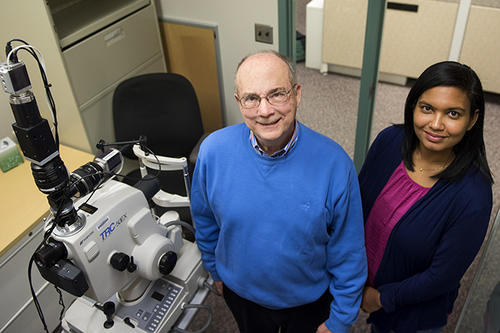
What if we could diagnose early-stage Alzheimer’s disease (AD) by looking into a person’s eyes?
A retinal scan technique, developed by researchers in the University’s Center for Drug Design (CDD), has the potential to detect AD in its early stages, when treatment may still be possible, and also to allow doctors to trace the progress of treatments and help the 100,000 Minnesotans with AD and their families.
The researchers developed a camera to scan retinas and detect small, soluble aggregates of a protein called A-beta. As AD progresses, the aggregates grow and are eventually deposited in the brain as insoluble clumps called plaques.
“We looked at retinas of [mouse models of AD],” says Bob Vince, CDD director. “We could see the aggregation progress of A-beta.”
If the technique proves itself as a way to closely follow AD, it will become of great value to drug discovery companies and long-term clinical care, says Kevin Nickels, a U technology licensing officer.
Science of scattering
In people or mice with early-stage AD, the small A-beta aggregates make retinal cells scatter light beams differently than healthy cells do, a difference the camera detects.
In mice, Vince and colleague Swati More, an assistant professor in CDD, have used the technique to follow the progress of the disease and trace the effects of anti-AD drugs. They have also tested about 20 patients so far, and seek to enroll more in a study of the scans’ ability to follow the clinical progression of the disease.
“Advancing this exciting technology will require funding a clinical study of seven to eight years, and this is being discussed with a couple of corporate parties,” Nickels notes.
Why test patients early?
“A lot of emphasis today is on getting early AD treatment,” says More. “We could tell patients if treatments are working, or recommend further psychological testing.”
- Categories:
- Science and Technology





